2011 TOYOTA YARIS SEDAN warning
[x] Cancel search: warningPage 323 of 406
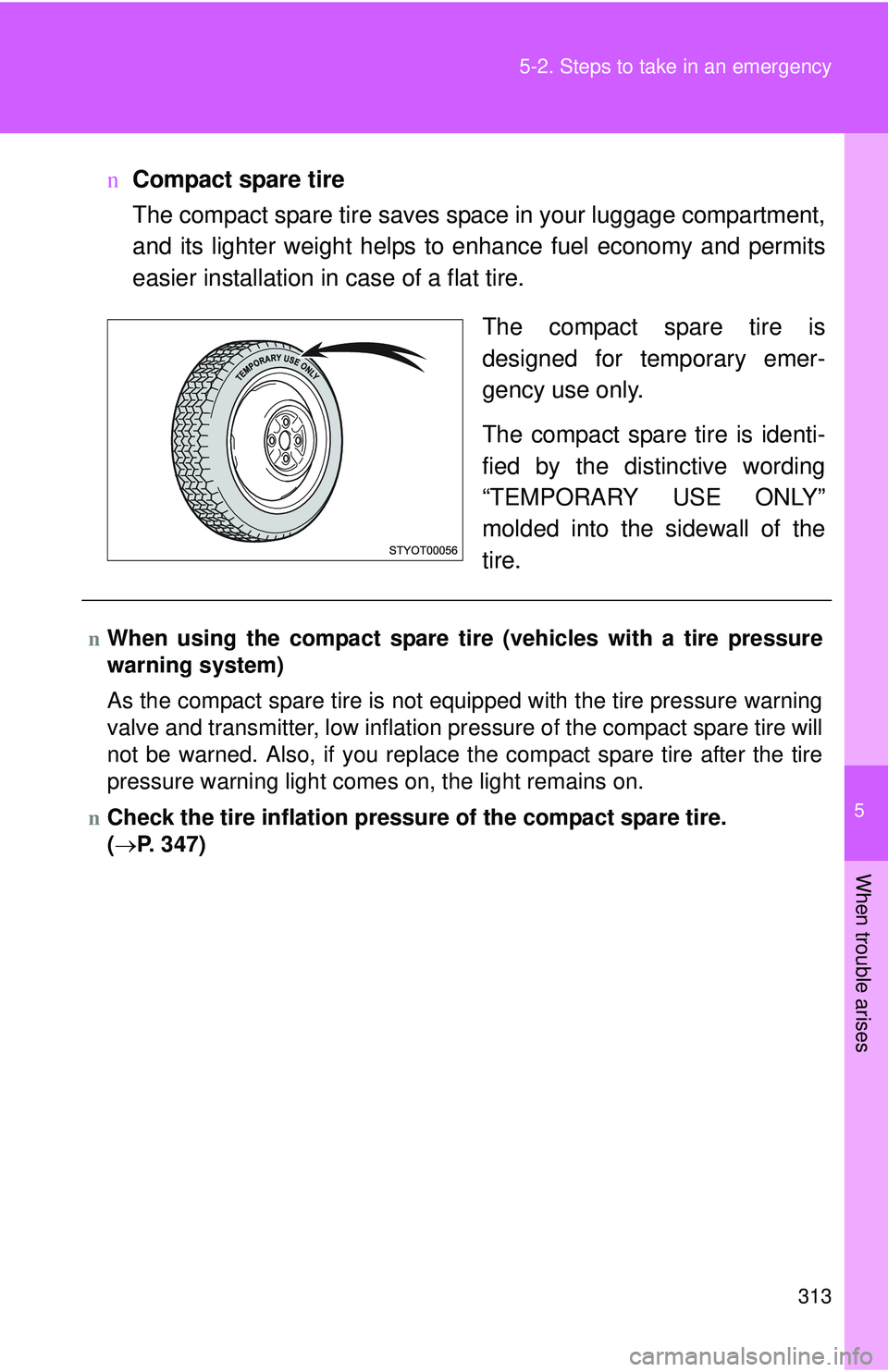
5
When trouble arises
313
5-2. Steps to take in an emergency
n
Compact spare tire
The compact spare tire saves space in your luggage compartment,
and its lighter weight helps to enhance fuel economy and permits
easier installation in case of a flat tire.
The compact spare tire is
designed for temporary emer-
gency use only.
The compact spare tire is identi-
fied by the distinctive wording
“TEMPORARY USE ONLY”
molded into the sidewall of the
tire.
nWhen using the compact spare tire (vehicles with a tire pressure
warning system)
As the compact spare tire is not equipped with the tire pressure warning
valve and transmitter, low inflation pr essure of the compact spare tire will
not be warned. Also, if you replace the compact spare tire after the tire
pressure warning light comes on, the light remains on.
nCheck the tire inflation pressure of the compact spare tire.
( → P. 347)
Page 331 of 406
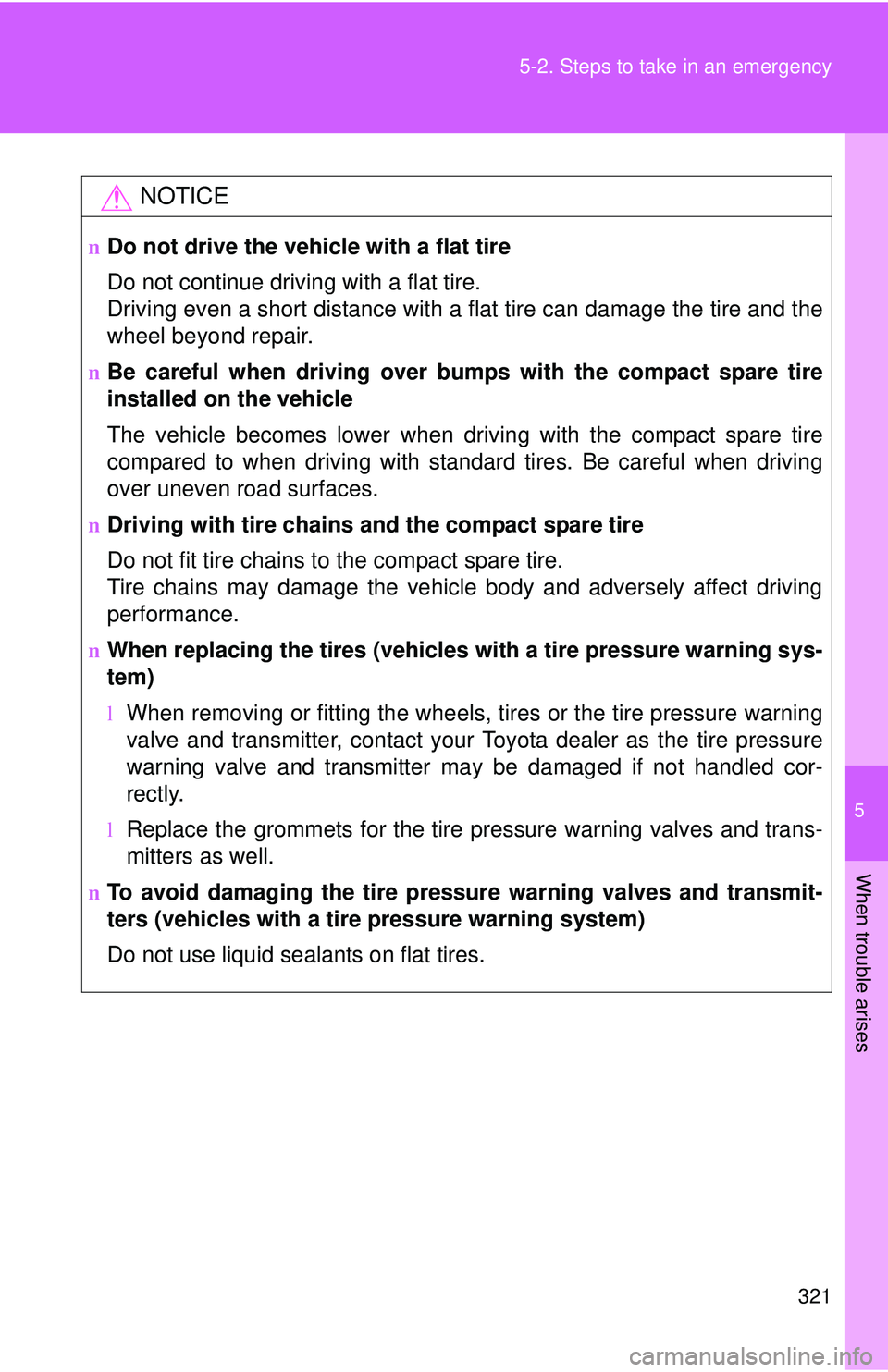
5
When trouble arises
321
5-2. Steps to take in an emergency
NOTICE
nDo not drive the vehicle with a flat tire
Do not continue driving with a flat tire.
Driving even a short distance with a flat tire can damage the tire and the
wheel beyond repair.
nBe careful when driving over bumps with the compact spare tire
installed on the vehicle
The vehicle becomes lower when driving with the compact spare tire
compared to when drivin
g with standard tires. Be careful when driving
over uneven road surfaces.
nDriving with tire chains and the compact spare tire
Do not fit tire chains to the compact spare tire.
Tire chains may damage the vehicle body and adversely affect driving
performance.
nWhen replacing the tires (vehicles with a tire pressure warning sys-
tem)
lWhen removing or fitting the wheels, tires or the tire pressure warning
valve and transmitter, contact your Toyota dealer as the tire pressure
warning valve and transmitter may be damaged if not handled cor-
rectly.
lReplace the grommets for the tire pressure warning valves and trans-
mitters as well.
nTo avoid damaging the tire pressure warning valves and transmit-
ters (vehicles with a tire pressure warning system)
Do not use liquid sealants on flat tires.
Page 339 of 406
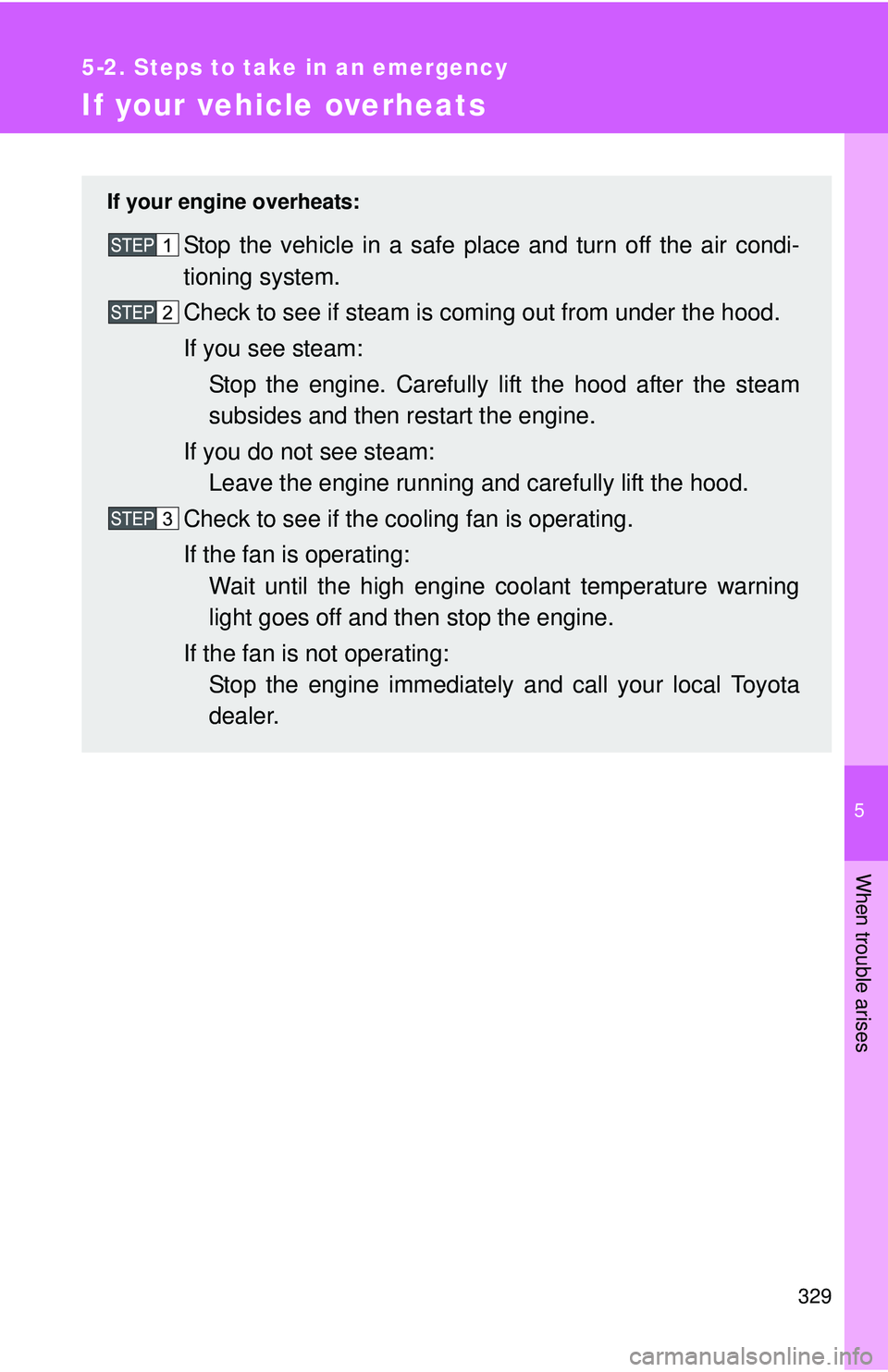
5
When trouble arises
329
5-2. Steps to take in an emergency
If your vehicle overheats
If your engine overheats:
Stop the vehicle in a safe place and turn off the air condi-
tioning system.
Check to see if steam is coming out from under the hood.
If you see steam: Stop the engine. Carefully lift the hood after the steam
subsides and then restart the engine.
If you do not see steam: Leave the engine running and carefully lift the hood.
Check to see if the cooling fan is operating.
If the fan is operating: Wait until the high engine coolant temperature warning
light goes off and then stop the engine.
If the fan is not operating: Stop the engine immediately and call your local Toyota
dealer.
Page 341 of 406
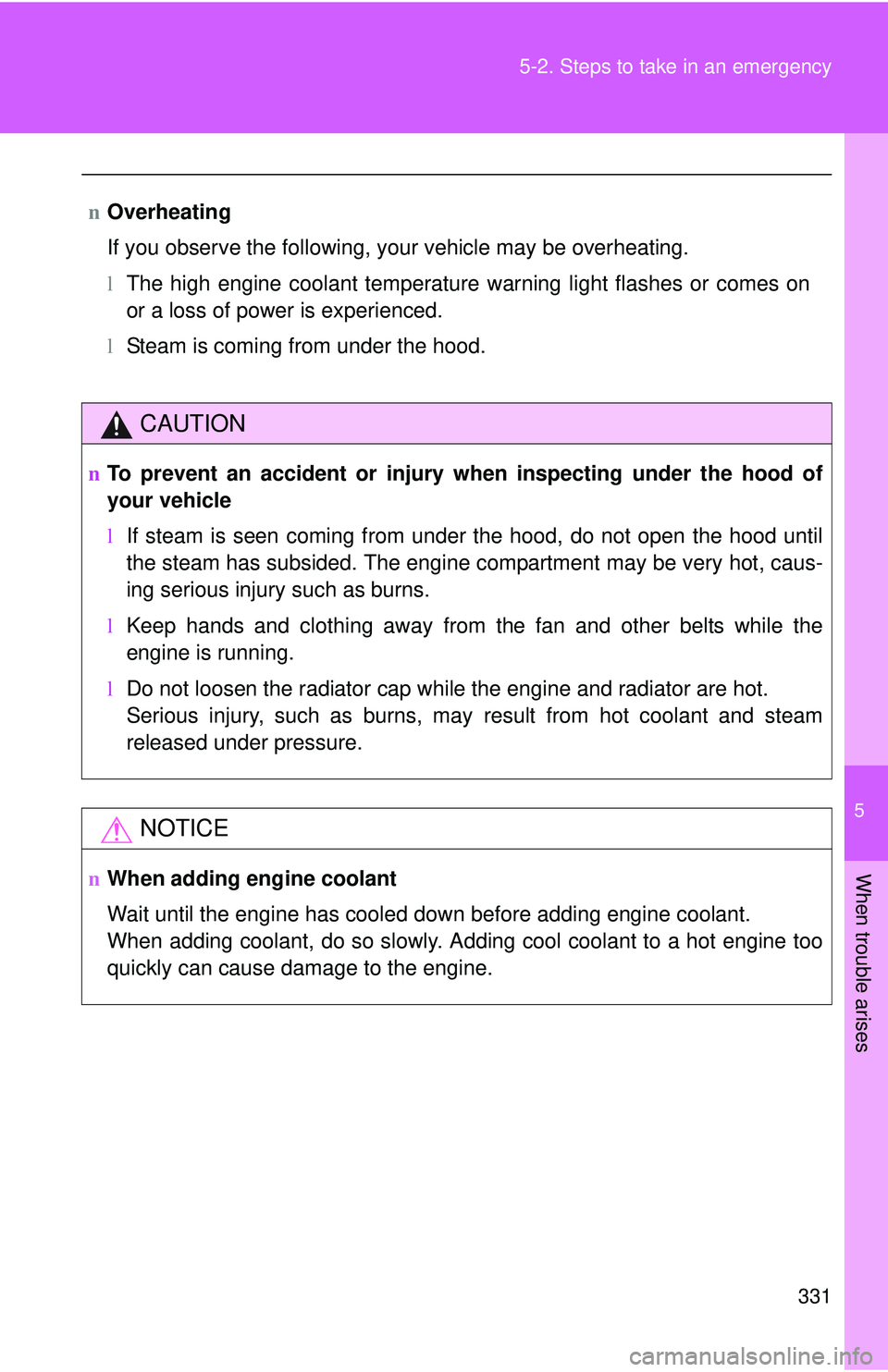
5
When trouble arises
331
5-2. Steps to take in an emergency
n
Overheating
If you observe the following, your vehicle may be overheating.
lThe high engine coolant temperature warning light flashes or comes on
or a loss of power is experienced.
l Steam is coming from under the hood.
CAUTION
nTo prevent an accident or injury when inspecting under the hood of
your vehicle
lIf steam is seen coming from under the hood, do not open the hood until
the steam has subsided. The engine compartment may be very hot, caus-
ing serious injury such as burns.
l Keep hands and clothing away from the fan and other belts while the
engine is running.
l Do not loosen the radiator cap while the engine and radiator are hot.
Serious injury, such as burns, may result from hot coolant and steam
released under pressure.
NOTICE
nWhen adding engine coolant
Wait until the engine has cooled down before adding engine coolant.
When adding coolant, do so slowly. Adding cool coolant to a hot engine too
quickly can cause damage to the engine.
Page 367 of 406
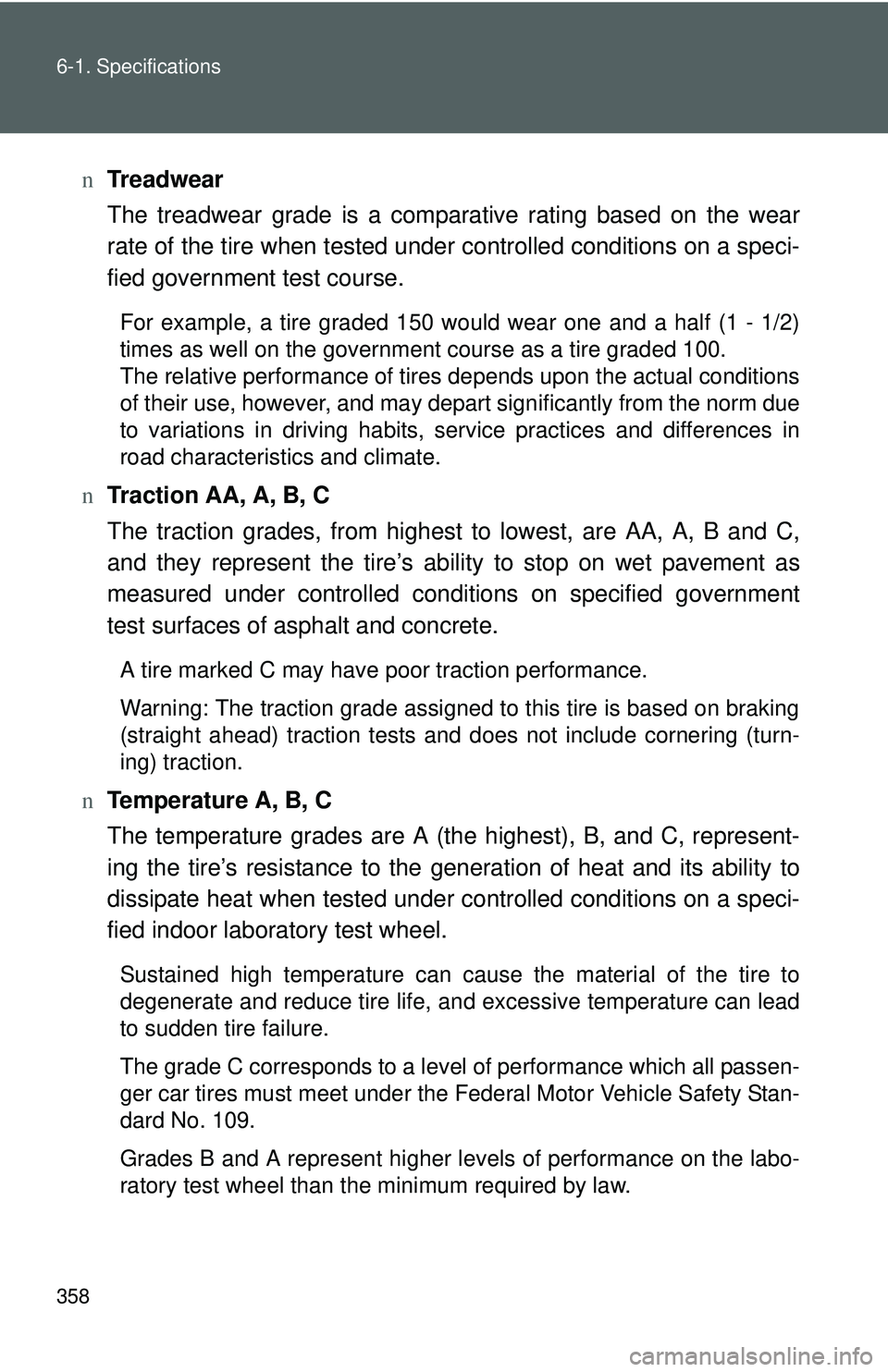
358 6-1. Specifications
nTreadwear
The treadwear grade is a comparative rating based on the wear
rate of the tire when tested under controlled conditions on a speci-
fied government test course.
For example, a tire graded 150 would wear one and a half (1 - 1/2)
times as well on the government course as a tire graded 100.
The relative performance of tires depends upon the actual conditions
of their use, however, and may depart significantly from the norm due
to variations in driving habits, service practices and differences in
road characteristics and climate.
n Traction AA, A, B, C
The traction grades, from highest to lowest, are AA, A, B and C,
and they represent the tire’s ab ility to stop on wet pavement as
measured under controlled cond itions on specified government
test surfaces of asphalt and concrete.
A tire marked C may have poor traction performance.
Warning: The traction grade assigned to this tire is based on braking
(straight ahead) traction tests and does not include cornering (turn-
ing) traction.
n Temperature A, B, C
The temperature grades are A (the highest), B, and C, represent-
ing the tire’s resistance to the generation of heat and its ability to
dissipate heat when tested under controlled conditions on a speci-
fied indoor laboratory test wheel.
Sustained high temperature can cause the material of the tire to
degenerate and reduce tire life, and excessive temperature can lead
to sudden tire failure.
The grade C corresponds to a level of performance which all passen-
ger car tires must meet under the Federal Motor Vehicle Safety Stan-
dard No. 109.
Grades B and A represent higher levels of performance on the labo-
ratory test wheel than the minimum required by law.
Page 368 of 406
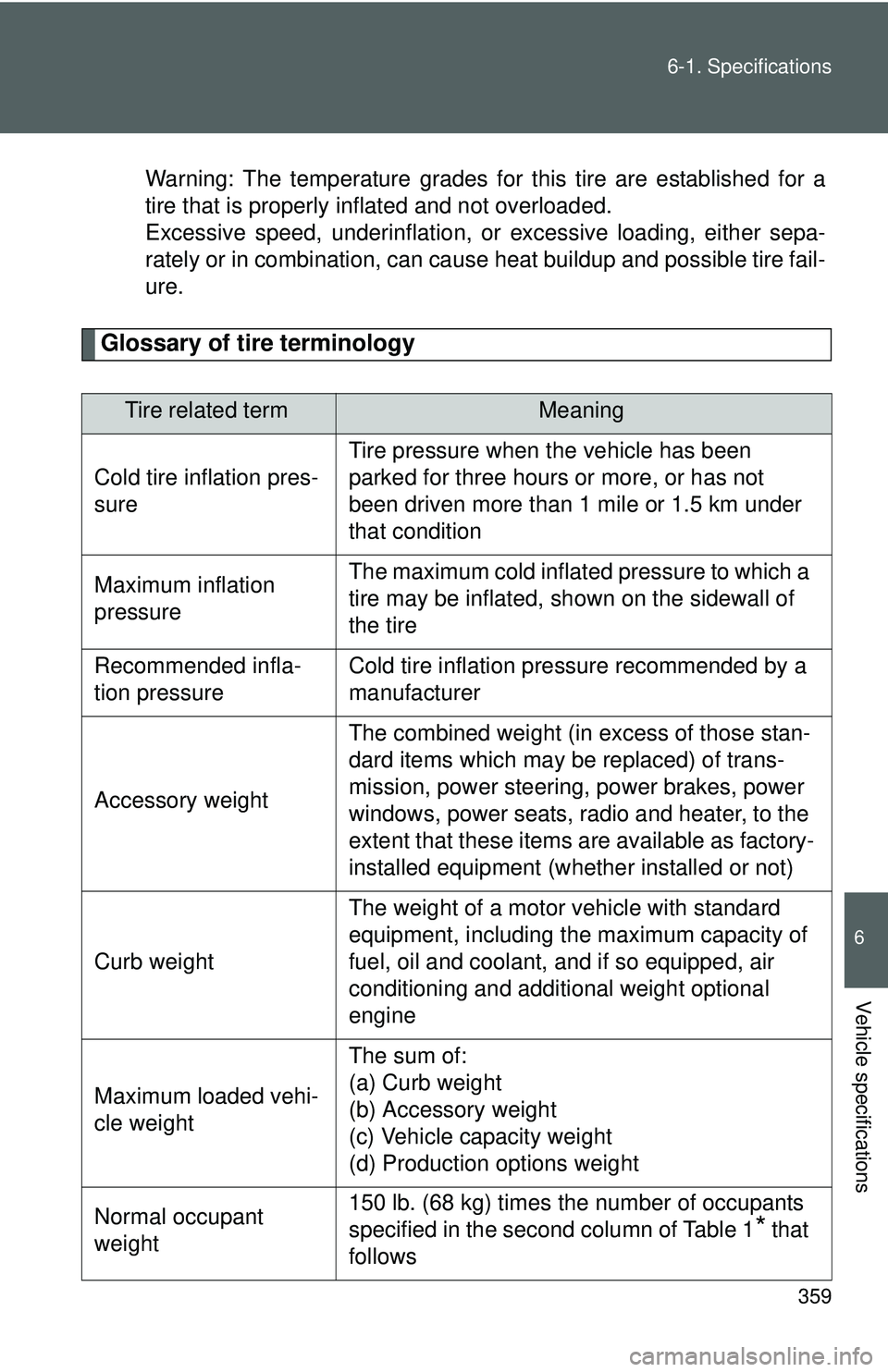
359
6-1. Specifications
6
Vehicle specifications
Warning: The temperature grades for this tire are established for a
tire that is properly inflated and not overloaded.
Excessive speed, underinflation, or
excessive loading, either sepa-
rately or in combination, can caus e heat buildup and possible tire fail-
ure.
Glossary of tire terminology
Tire related termMeaning
Cold tire inflation pres-
sure
Tire pressure when the vehicle has been
parked for three hours or more, or has not
been driven more than 1 mile or 1.5 km under
that condition
Maximum inflation
pressureThe maximum cold inflated pressure to which a
tire may be inflated, s hown on the sidewall of
the tire
Recommended infla-
tion pressureCold tire inflation pressure recommended by a
manufacturer
Accessory weight
The combined weight (in excess of those stan-
dard items which may be replaced) of trans-
mission, power steering, power brakes, power
windows, power seats, radio and heater, to the
extent that these items are available as factory-
installed equipment (whether installed or not)
Curb weight
The weight of a motor vehicle with standard
equipment, including the maximum capacity of
fuel, oil and coolant, and if so equipped, air
conditioning and additional weight optional
engine
Maximum loaded vehi-
cle weight
The sum of:
(a) Curb weight
(b) Accessory weight
(c) Vehicle capacity weight
(d) Production options weight
Normal occupant
weight150 lb. (68 kg) times the number of occupants
specified in the second column of Table 1
* that
follows
Page 391 of 406
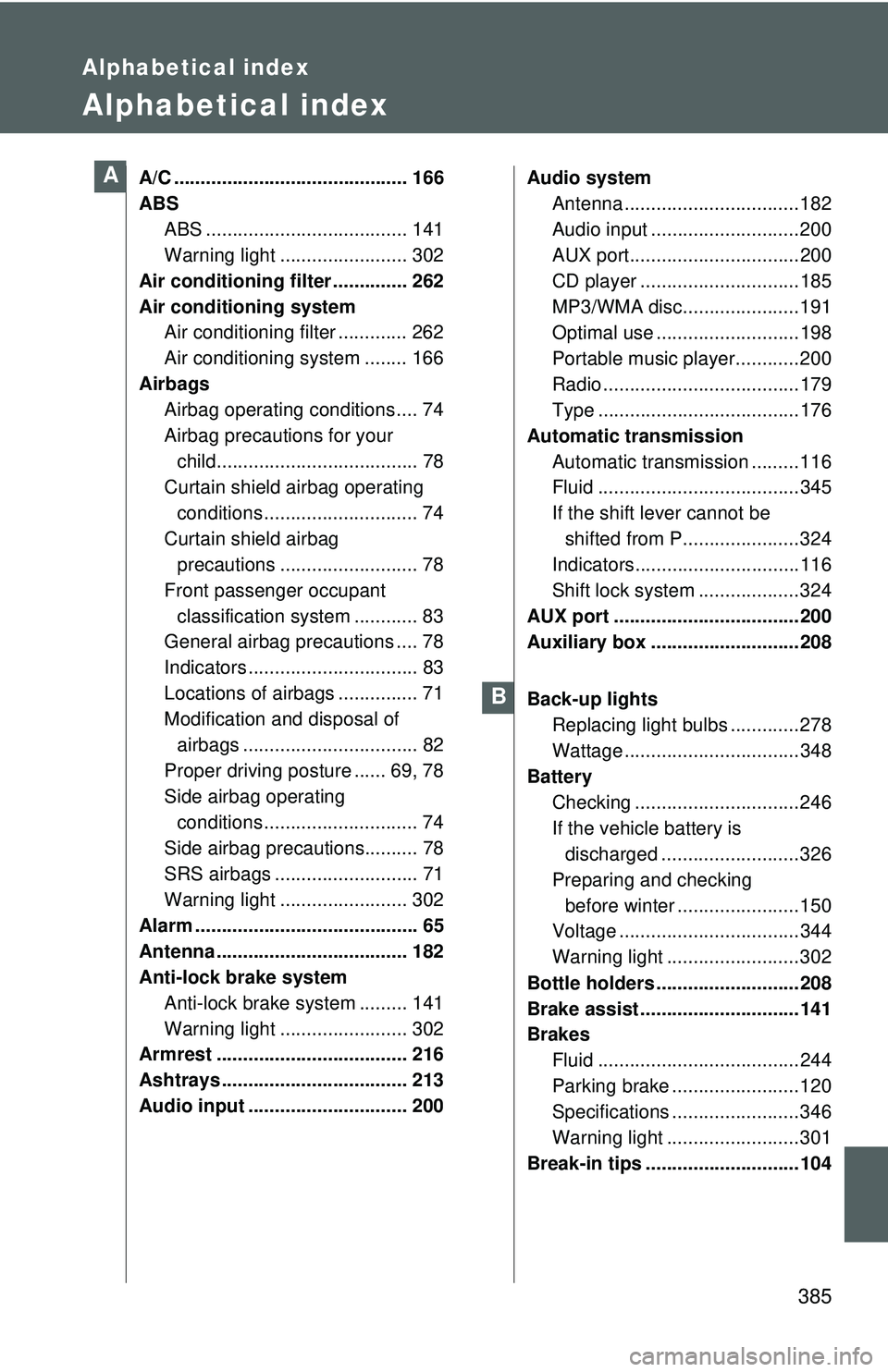
385
Alphabetical index
Alphabetical index
A/C ............................................ 166
ABSABS ...................................... 141
Warning light ........................ 302
Air conditioning filter .............. 262
Air conditioning system Air conditioning filter ............. 262
Air conditioning system ........ 166
Airbags Airbag operating conditions .... 74
Airbag precautions for your
child...................................... 78
Curtain shield airbag operating
conditions ............................. 74
Curtain shield airbag precautions .......................... 78
Front passenger occupant classification system ............ 83
General airbag precautions .... 78
Indicators ................................ 83
Locations of airbags ............... 71
Modification and disposal of
airbags ................................. 82
Proper driving posture ...... 69, 78
Side airbag operating conditions ............................. 74
Side airbag precautions.......... 78
SRS airbags ........................... 71
Warning light ........................ 302
Alarm .......................................... 65
Antenna .................................... 182
Anti-lock brake system Anti-lock brake system ......... 141
Warning light ........................ 302
Armrest .................................... 216
Ashtrays ................................... 213
Audio input .............................. 200 Audio system
Antenna .................................182
Audio input ............................200
AUX port................................200
CD player ..............................185
MP3/WMA disc......................191
Optimal use ...........................198
Portable music player............200
Radio .....................................179
Type ......................................176
Automatic transmission Automatic transmission .........116
Fluid ......................................345
If the shift lever cannot be shifted from P......................324
Indicators...............................116
Shift lock system .... ...............324
AUX port ...................................200
Auxiliary box ............................208
Back-up lights Replacing light bulbs .............278
Wattage .................................348
Battery
Checking ...............................246
If the vehicle battery is discharged ..........................326
Preparing and checking before winter .......................150
Voltage ..................................344
Warning light .........................302
Bottle holders ...........................208
Brake assist ..............................141
Brakes Fluid ......................................244
Parking brake ........................120
Specifications ........................346
Warning light .........................301
Break-in tips .............................104A
B
Page 392 of 406
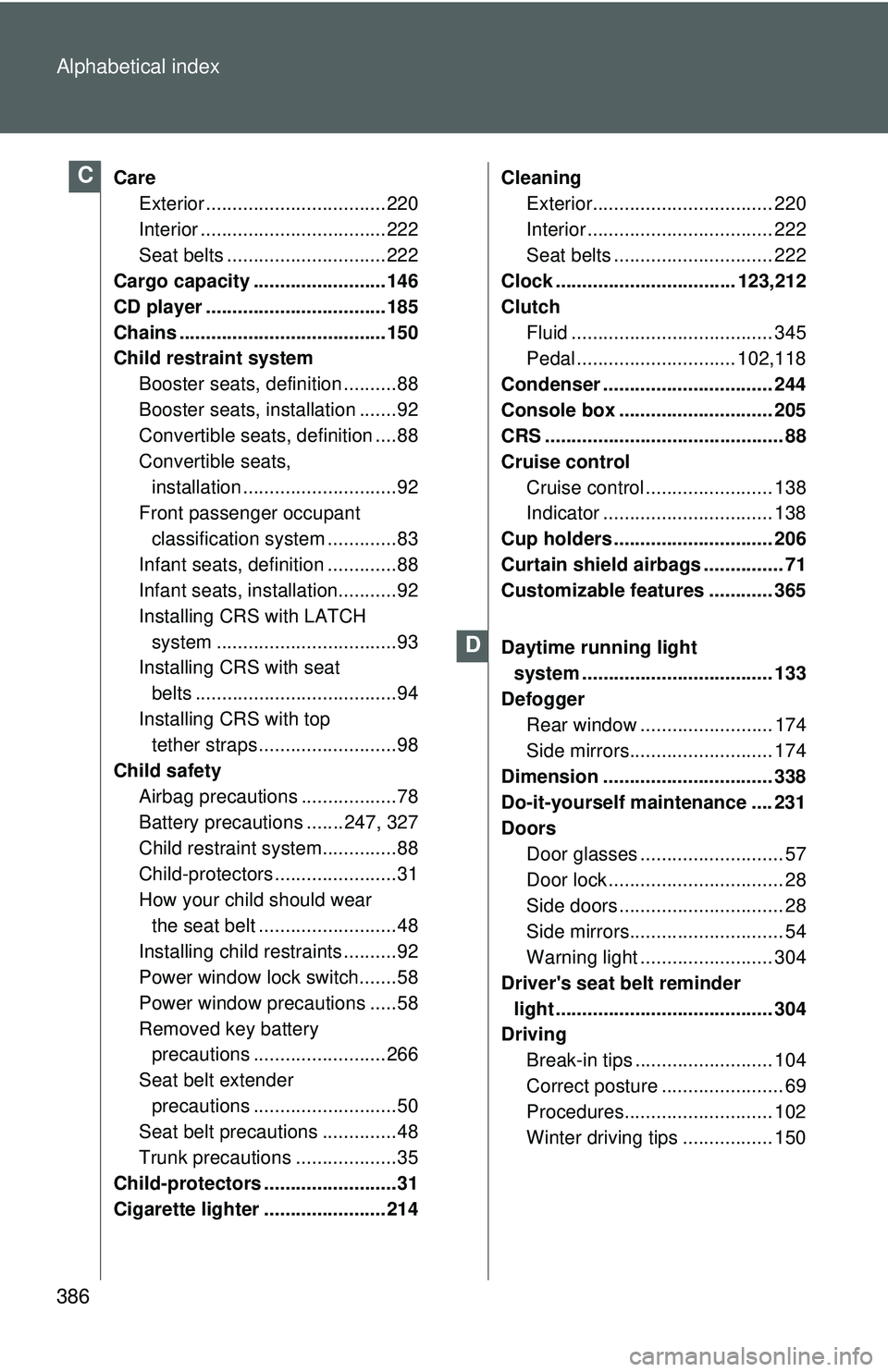
386 Alphabetical index
CareExterior .................................. 220
Interior ................................... 222
Seat belts .............................. 222
Cargo capacity ......................... 146
CD player .................................. 185
Chains ....................................... 150
Child restraint system
Booster seats, definition ..........88
Booster seats, installation .......92
Convertible seats, definition ....88
Convertible seats, installation .............................92
Front passenger occupant
classification system .............83
Infant seats, definition .............88
Infant seats, installation...........92
Installing CRS with LATCH system ..................................93
Installing CRS with seat
belts ......................................94
Installing CRS with top tether straps ..........................98
Child safety Airbag precautions ..................78
Battery precautions ....... 247, 327
Child restraint syst em..............88
Child-protectors .......................31
How your child should wear the seat belt ..........................48
Installing child restraints ..........92
Power window lock switch.......58
Power window precautions .....58
Removed key battery precautions ......................... 266
Seat belt extender precautions ...........................50
Seat belt precautions ..............48
Trunk precautions ...................35
Child-protectors .........................31
Cigarette lighter ....................... 214 Cleaning
Exterior.................................. 220
Interior ................................... 222
Seat belts .............................. 222
Clock .................................. 123,212
Clutch
Fluid ...................................... 345
Pedal .............................. 102,118
Condenser ................................ 244
Console box ............................. 205
CRS ............................................. 88
Cruise control Cruise control ........................ 138
Indicator ................................ 138
Cup holders .............................. 206
Curtain shield airbags ............... 71
Customizable features ............ 365
Daytime running light system .................................... 133
Defogger Rear window ......................... 174
Side mirrors........................... 174
Dimension ................................ 338
Do-it-yourself maintenance .... 231
Doors Door glasses ........................... 57
Door lock ................................. 28
Side doors ............................... 28
Side mirrors............................. 54
Warning light ......................... 304
Driver's seat belt reminder light ......................................... 304
Driving
Break-in tips .......................... 104
Correct posture ....................... 69
Procedures............................ 102
Winter driving tips ................. 150C
D